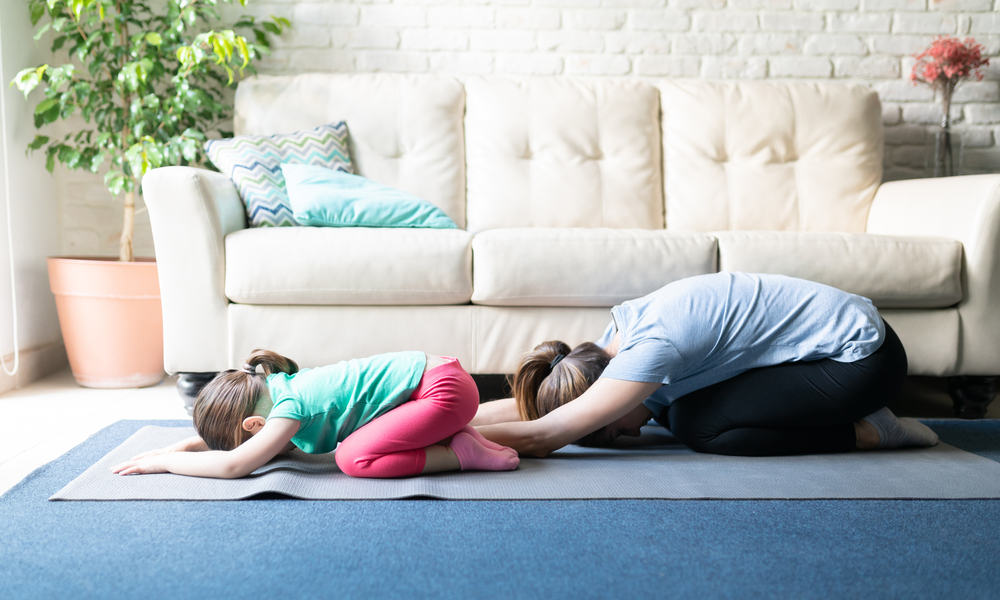Yoga poses are known to be calming and a great workout for adults. It is not often, on the other hand, that you hear about yoga for children. That’s too bad, in particular because our children’s lives have been upended by COVID-19. Everything that used to be a part of their routine before the pandemic, like schooling and playdates, has been moved to the digital screen or canceled. As a result, our kids are stressed, and yoga poses may just help them cope.
Parents should be having honest, open discussions with their children about coronavirus. This includes answering kids’ questions in a way that doesn’t panic them. You can talk about preventive measures against COVID-19 like masks, social distancing, and good hygiene. No less important, however, is supporting our children’s general physical and mental health. This is where introducing kids to mindful yoga exercises comes in.
Yoga has a very nurturing effect on a child’s growth. Rooted in ancient India, yoga exercises promote a unique blend of relaxation, mind-body healing, and physical development. In short, most of what children need to help them grow into healthy adulthood.
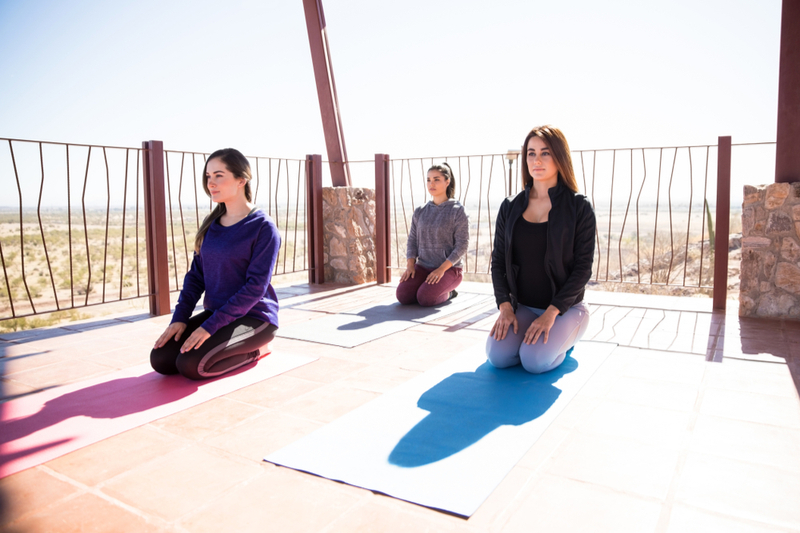
Mind-Body Benefits of Yoga for Kids
Yoga for children is fun and leads to greater flexibility and focus. Parents, teachers, and school administrators across the globe, have begun to recognize that yoga can lead to improvements in concentration, emotional regulation, and cooperation. It goes without saying that yoga for children also takes them away from their screens and digital toys, engaging them instead in healthy physical activity. But a 2009 pilot study on the effect of yoga on children’s well-being went even further. Just 12 weeks of yoga were enough to reduce negative behaviors brought on by stress in 4th and 5th graders. The 12-week program also brought significant improvements in maintaining balance.
1. Neuromuscular Benefits of Yoga
Studies have shown that yoga has a positive impact on motor skills. Yoga also improves reaction time, planning, execution time, and motor speed in children. These observed benefits of yoga combine to make children more efficient, more able to concentrate and stay focused on tasks.
2. Cardiopulmonary Benefits of Yoga
Yoga has been shown to have cardiopulmonary benefits that improve the functioning of the heart and lungs. Strengthening the function of these major organs may be of particular benefit during the pandemic. Coronavirus attacks the body’s respiratory system, which is dependent on lung function.
Our heart and lungs also play a critical role in stress management, which can help children cope with their emotions during the pandemic. Yoga reduces the stress hormone cortisol in children. Children who practice yoga also have stable, reduced resting heart rates, and improved blood circulation. These physical benefits indicate that yoga reduces fear and anxiety in children. A reduction in stress, meanwhile, is good for the lungs and heart, preserving and even improving their function.
3. Musculoskeletal Benefits of Yoga
Yoga training improves the musculoskeletal system in kids to help prevent many common orthopedic injuries. Children who practice yoga have improved handgrip strength, endurance, and muscle strength. Practicing yoga on a regular basis can turn these musculoskeletal benefits into long term gains, well into adulthood. Regular yoga practice can also prevent childhood obesity which can lead to a host of musculoskeletal issues, such as ankle, foot, and knee problems.
COVID-19 and Stress Levels in Children
Children are known to be always on the move. Now, for the greater part of the year, they have been locked inside their homes, due to the pandemic. This places an enormous strain on our children, elevating their levels of stress and anxiety. Here are some of the ways COVID-19 has produced stress in our children’s lives:
Distance from Friends and Peers
Aside from the direct impacts of the pandemic, the greatest trauma to children during this time is being distanced from their friends. Just as adults benefit from interactions with their co-workers in the workplace, so too, children benefit from being with their classmates in school. Being with friends and peers introduces children to basic life skills such as communication, interpersonal relations, emotional reasoning, creative thinking, and cognitive control.
With reduced playtime and school time, kids are already struggling to cope with loneliness and the dull monotony of being alone. But being out of school and away from other children also impacts their learning. Aside from all these negative effects, being away from peers also has an effect on stress management.
In the current pandemic situation, children may be delayed in the development of these basic life skills. And more importantly kids are on a strict time-based developmental process—they need to meet benchmarks for their age. If they fail to do so, they are more likely to experience emotional difficulties in and throughout adolescence.
What Can Yoga Do?
Regular and systematic yoga practice can train and stimulate the central and peripheral nervous systems for healthy brain activity in children. A well- nourished, stimulated, and trained nervous system can help children develop many intellectual and cognitive abilities for dealing with stress. With time, the therapeutic and soothing effects of yoga can optimize hormonal and metabolic activity to lower the child’s general stress levels.
Disruption of Student-Mentor Relationship
Mental health and growth is stimulated by daily mental exercises, problem-solving tasks, information-processing and knowledge-gathering. All of these activities are a byproduct of the student-mentor relationship. With online classes spanning the globe, the direct interaction between students and mentors have evaporated. And one has to admit that the online, compared to in-person interactions, fall short. Interaction with teachers and mentors helps children to develop the moral fiber and mental motivation essential to staying focused and dealing with frustration.
What Can Yoga Do?
Yoga practices enhance awareness and consciousness, factors not otherwise easily cultivated in a child. The body awareness required to pose with accuracy, the conscious movement of muscles and controlled breathing, are all elements of yoga practice that strengthen awareness and consciousness. With these benefits also comes improvement in focus, determination and will power, to keep children motivated and absorbed.
Stress-Relieving Yoga Exercises for Children
The following yoga poses offer benefits to digestion, metabolism, blood flow, neural stimulation, and hormone secretion, leading to better stress management.
1. Child’s Pose

Child’s pose is a stress-relieving pose, with hormonal and metabolic benefits. This is also a great pose for relaxation.
- Kneel down on the floor, with the knees and feet joined.
- Fold and bend the knees and sit back on the heels.
- Keep the upper body straight.
- Raise the hands straight overhead.
- Bend forward all the way down, so that the chest touches the knees.
- Rest the hands, extending in front, on the floor.
- Stretch the upper body forward, and touch the forehead to the ground.
- Breathe steadily and hold the pose for 20-30 seconds.
Suggested Modification: Instead of resting the head on the floor, place a sponge block or a firm cushion below the forehead, for comfort.
2. Tree Pose
Tree pose teaches balance, cognitive control, and more efficient use of the nervous system.
- Stand straight in mountain pose.
- The spine should be erect, shoulders pressed down, hands by the sides of the body, and legs hip-width apart.
- Shift your body weight to the right leg, and lift off with the left foot.
- Balancing on your right leg, lift your left foot, and place it against the inside of the right thigh.
- Try not to wobble, remain still.
- Raise both hands in front of your heart, palms together, then once you feel steady, raise your arms over your head.
- Breathe steadily and hold the pose for 30 seconds.
- Repeat the pose, balancing on the left leg.
Suggested Modification: The key to staying in balance is to consciously focus on all the important muscle groups, such as abs, hamstrings, calf muscles, back muscles, shoulder muscles, and lower back. All the muscle groups need to actively hold the pose for balance. To support this level of consciousness in a child, try placing a supportive strap around each muscle group. This will help the child to consciously focus on each muscle group.
3. Thunderbolt Pose
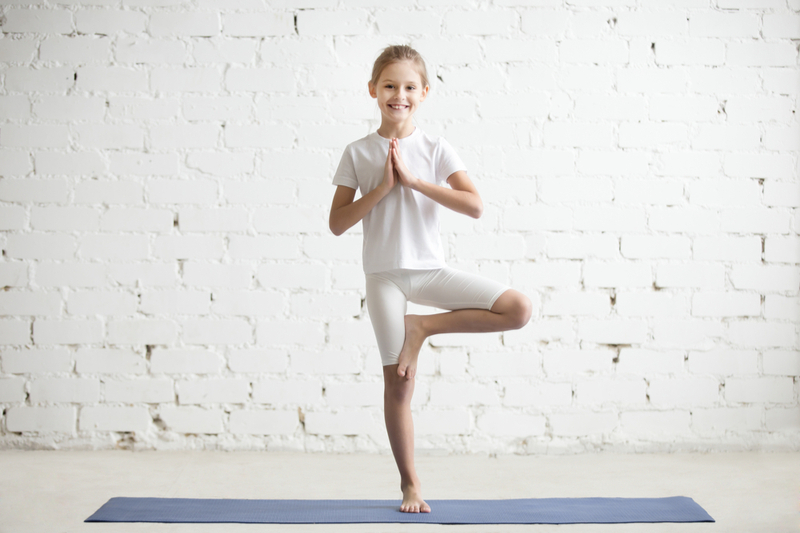
Thunderbolt bolt pose improves digestion, metabolism and blood flow.
- Kneel down on the floor, with the knees and feet together.
- Keeping knees and feet together, lower your bottom and sit back on your heels.
- Keep your upper body straight.
- Raise your hands straight up
- Bend forward all the way down, so that your chest touches the knees.
- Extend your hands frontward so they are touching the floor.
- Stretch your upper body forward, and touch your forehead to the ground.
- Breathe steadily and hold the pose for 20-30 seconds.
Suggested Modification: This pose is very still and might be a bit too dull for a kid’s taste. Include a few hand mudras, head rotation, and eye exercises, to diversify the benefits and add spice. Place a yoga block or pillow between the feet for less stress on the knees.
4. Frog Pose
This variation of the frog pose enables the body functions needed for proper metabolism and improved digestion.
- Sit in a thunderbolt pose.
- Set both hands against the belly.
- Exhale and gently press in the tummy against the spine.
- Keeping the stomach pressed in, bend forward completely to touch the chest with the knees.
- Breathe in this pose for about 10-15 seconds and repeat the pose three times.
Suggested Modification: When a child performs this pose, s/he may miscalculate how much pressure to apply to the tummy. Use a yoga block, a firm cushion or a folded blanket between tummy and thighs, to generate the right amount pressure on the abdomen
5. Crocodile Pose
Crocodile pose is a restorative and relaxing pose that also stimulates the central nervous system. This pose also has respiratory benefits.
- Lie on your front with the tops of your feet on the ground
- Keep the feet a little wider than hip width apart.
- Rest your elbows on the ground, and cross your hands to make a place to rest your forehead
- Lift the upper body to open the chest and release tension in your shoulders and back
- Keep the shoulders nicely pressed down, and chest extended out.
- Look forward and breathe steadily.
- Hold the pose for 20-30 seconds.
Suggested Modification: Instead of resting your chin on your hands, use a yoga bolster or a couple of pillows. The child can rest his/her chin on the bolster, and even hug it for a better grip. This modification will allow the child to practice the pose during other activities like watching television.
6. Standing Forward Bend Pose
Standing forward bend is great for flexibility and digestion. This pose also helps in clearing the body of harmful toxins.
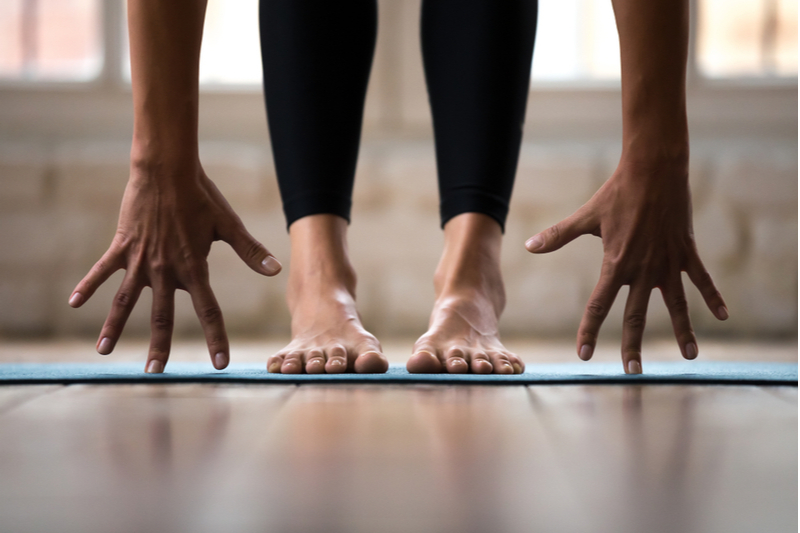
- Stand in mountain pose.
- Raise the hands straight overhead.
- Bend the body from the groin.
- Bend forward all the way to touch the feet with the hands.
- Remember not to bend your knees.
- Hold the pose for 5-7 breaths, and repeat the pose three times.
Suggested Modification: Most kids love this pose, but they almost always bend their knees. For kids, it may help to turn this into a repetitive pose. Have the child bend down for 2 seconds and then get back up. Repeat these steps around 10 times.
7. Cobra Pose
Cobra pose is the best pose for the central nervous system, improving cognitive control, concentration, and awareness.
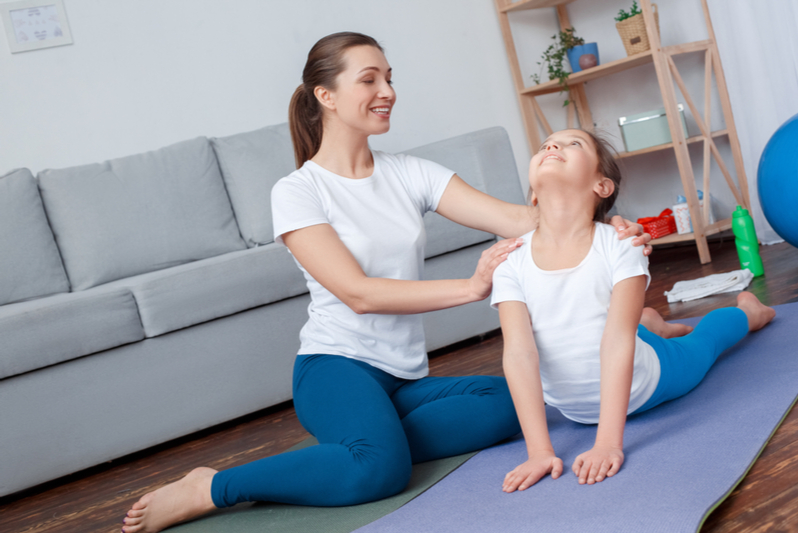
- Lie on the floor, with the front of the body facing the floor.
- Keep the legs hip-width apart.
- Place palms against the ground directly under your shoulders
- Push against the floor, inhale as you lift your chest off the floor.
- Keep lifting your chest until your arms straighten, keeping your chest and head facing front.
- Press the shoulders firmly down, and push out your chest.
- Keep the curve of your spine even from bottom to top.
- Your pelvis should touch the ground.
- Hold the pose for 5 breaths and repeat the pose three times.
Suggested Modification: Cobra pose requires a lot of awareness to arch the spine, and prevent injury. The parent should remain close to the child at all times during this pose. Better yet the parent can press and apply pressure to specific regions of the spine to guide the arching of the upper body.
8. Legs Up The Wall Pose
Legs up the wall is good for your blood flow and nerves. This pose is a great relaxation pose.
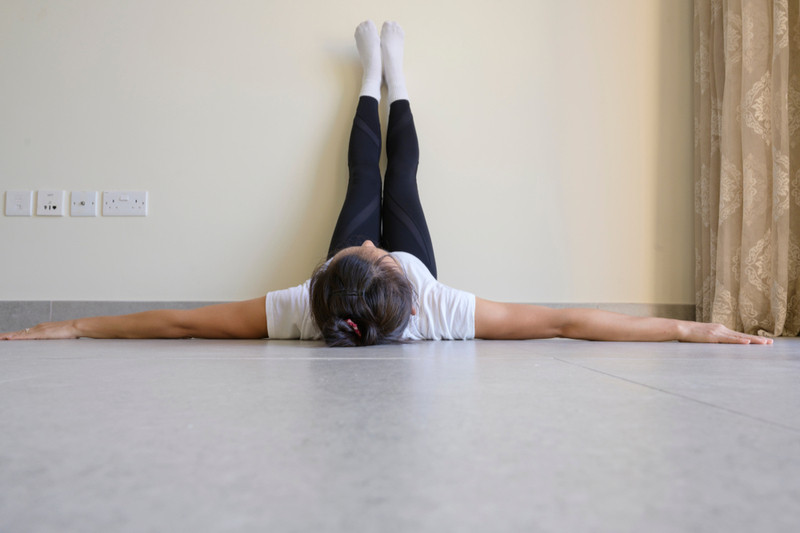
- Sit sideways next to a wall with your right hip and shoulder as close to the wall as possible.
- Swivel your body so that your legs and feet go up the wall.
- Stretch out your arms and extend them straight out, to either side of your body.
- Breathe comfortably and stay in the pose for about a minute.
- Make sure that the “sit bones” are right at the intersection where floor and wall, meet.
Suggested Modification: For kids, legs up the wall can be practiced without a wall. Simply lift the legs and hold them in the legs up the wall pose. This variant can be better for a child’s level of strength, control, and concentration.
